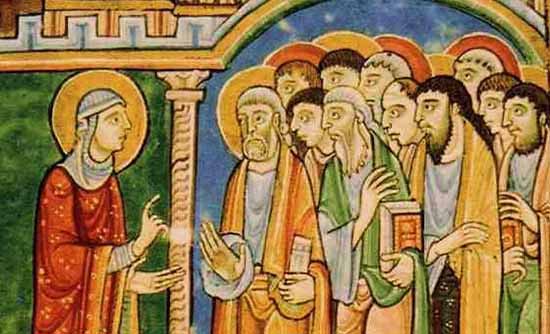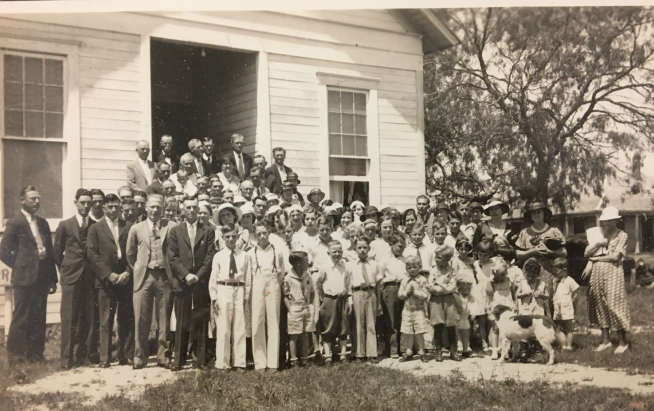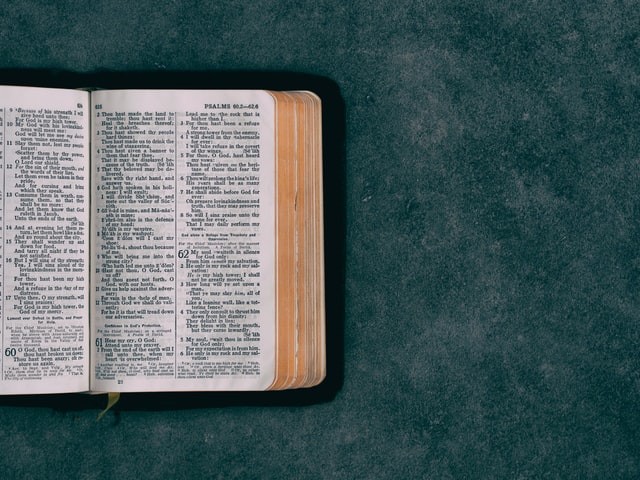The Medieval Counsel of Biblical Womanhood
The Council for Biblical Manhood and Womanhood exploded my twitter feed last week. As a Texan with both friends and family in Houston, I really just wanted to see the update on Hurricane Harvey. But the Nashville Statement dominated my news feed. I confess after scrolling through headline after headline I mostly just felt tired.
One article revived me. Written by Jeffrey Miller, a Bible professor and editor of the Priscilla Papers, the article highlights women, from the pages of church history ancient through modern, who exercised ecclesiastical authority: prophesying, preaching, leading. His list tilts toward modern history, but he does highlight a few medieval women: including Hilda of Whitby, Leoba, and Clare of Assisi. Miller assumes his audience lacks knowledge about these women. For example, he writes, “Unfortunately you have probably not heard of Lioba, a biblical scholar, church historian, and missionary to Saxony in the 8th century–long before second-wave feminism.”
I think Miller is absolutely right. These women represent a history that is largely unknown by modern Christians.
I have been teaching women’s history at Baylor since 2008. Most of my students are pretty familiar with historical patriarchy and the (legal, religious, economic, social) subordination of women. They know the narrative that Eve caused Adam to sin and, consequently, women were cursed to have pain in childbearing and live under their husband’s authority. For the vast majority of my students, however, my classroom is their first introduction to the female preachers and church leaders who were so well known in medieval Europe.
Now, before I continue, let me clarify. I will never argue that the medieval church was a golden age for women. It wasn’t. Because of the sin of Eve, women were regarded as weaker than men and more prone to sin (especially sexual sin). Most women were legally under the authority of their husbands and male relatives, and this legal subordination was reinforced by medieval theology. At the same time, however, medieval theology really did support women as spiritually equal to men; medieval women could overcome the limitations of their sex and exercise spiritual authority.
Mary Magdalene is a prime example. Her exemplary penance and steadfast belief in Jesus allowed her to be completely redeemed from her life of prostitution and become an exemplar of female preaching and leadership from the ancient church through the fifteenth century. One of the most popular sermon collections in late medieval England, Festial, presents Mary Magdalene as a missionary of Christ affirmed by Peter. She preaches openly, performs miracles that parallel those of the apostles, and converts a new land to the Christian faith. Medieval Christians regarded Mary Magdalene as the “apostle to the apostles.” Even though we now doubt the historical accuracy of her missionary journey to France, medieval Christians didn’t. They saw Mary Magdalene as a model female leader–a brave woman who dared to share the good news about Jesus when men lacked the courage to do so (see my 2014 article in Fourteenth-Century England).
And Mary Magdalene was far from alone.
She is just one of many female preachers, missionaries, and ecclesiastical leaders who fill the religious texts and historical landscape of medieval Europe. The Burgundian princess Clotilda defied her pagan husband Clovis in the late fifth century, eventually converting him along with his Frankish followers to Christianity. Jane Tibbets Schulenburg, in her Forgetful of their Sex, Female Sanctity and Society, Ca. 500-1100, remarks that Clotilda assumed the primary role in converting her husband as Clovis invokes the “Christ of Clotilda.” What is more, medieval historians and clergy recognized Clotilda’s leadership and gave her the credit rather than to the officiating clergy. As a medieval account records, “Let us recall that there were in the kingdom of the Franks some noble queens, true servants of God: Clotild, first of all, wife of the first Clovis, niece of Gundobad, who through holy exhortation converted to Christianity and the catholic faith her most powerful and pagan husband with him many of the Franks.”
Hilda of Whitby presided as abbess over a double-monastery in 7th-century England, which meant she was the ecclesiastical leader of both monks and nuns. She turned her monastery into one of the most well-known educational centers in medieval Europe, and five men who studied Scripture under her became bishops. As the Venerable Bede wrote, “so great was her prudence that not only ordinary folk, but kings and princes used to come and ask her advice in their difficulties and take it.” Hilda of Whitby also hosted a synod in 616 which standardized the date of Easter in England. Hildegard of Bingen preached regularly to clergy and laity alike in medieval Europe, undertaking four preaching tours between 1158 and 1170. Margery Kempe knew scripture so well that she could quote Paul back to the Archbishop of York. She may not have officially preached, but she defied the authority of her husband, she defied the authority of ecclesiastical leaders, and she publicly taught scriptural lessons to clergymen (preached?).
I could go on, discussing Radegund, Leoba, Matilda of Tuscany, Rose of Viterbo, Christine de Pizan, Catherine of Siena, and etc., but I think you get the point. Women preaching and exercising ecclesiastical authority has been a part of Christianity from the beginning. Ellen Lawless writes, in Women Preachers and Prophets through Two Millennia of Christianity, that, “women have been preaching in the Christian tradition from the earliest historical moments, perhaps only days after Jesus Christ was crucified and his resurrection announced.”
So why don’t we know this history better? Or, more to the point, why don’t most evangelical Christians (especially conservative evangelical Christians) know the history of female Christian leadership better?
There are probably several reasons. Lawless suggests one that is really interesting. She suggests that the lack of scholarly attention to female leaders in Christian history has to do with a “bias against recognizing women’s contributions.” Whether an unconscious or an intentional bias, I couldn’t say for sure. But I do know that I just flipped through the index of two very popular Christian history textbooks, Church History in Plain Language by Bruce Shelley (4th edition) and The Story of Christianity: The Early Church to the Dawn of the Reformation by Justo L. Gonzalez (revised and updated), as well of a popular Sunday School church history text, Christian History Made Easy by Timothy Paul Jones (2013 ed).
In Christian History Made Easy, which comes with leader versions, student versions, and a video series, I found 12 women listed in the index (of course, that is 12 women in comparison to approximately 140 men…so roughly 8% of the people listed in the index are women). Anyway, 4 of these women were medieval–Julian of Norwich, Joan of Arc, Hilda of Whitby, and Hildegard of Bingen. Jones praises Hilda of Whitby as training “hundreds of nuns and even some monks–five of whom became overseers”. But when he discusses Hildegard of Bingen, he describes her as a, “Renaissance woman in the Middle Ages….a musician and mystic, artist and author, proclaimer of truth and prophet of reform. Popes and emperors praised her. Only Bernard surpassed her prestige.” Hildegard of Bingen proclaims, reforms, and writes; she does not, in Christian History Made Easy, preach.
The Story of Christianity has a much more developed index with over a 1000 entries. I know the author was serious about including women, and in fact writes in the intro that, “this Story seeks to acknowledge the role of women throughout the life of the church in a way that most earlier histories did not…our age has become much more aware of the significant contribution of women to every era, and particularly to the life of the church” (4). I did count at least 32 individual women listed in the index as well as an index heading for “women.” As there are more than 1000 entries, over 500 of which are men, women still comprise only 6ish% of the people listed in the index. Once again, Hildegard of Bingen is not described as preaching. She is a “German Benedictine abbess whose mystical writings became popular among those who sought a more profound spiritual life” (328). Catherine of Siena, a fourteenth-century Dominican tertiary, gets a more developed discussion than Hildegard(399). Beverly Kienzle, one of the leading scholars in medieval preaching and sermon studies, argues that Catherine of Siena was also a preacher, achieving “the conversion of the listeners and the spiritual refreshment of both the audience and the preacher herself.” Yet The Story of Christianity describes her only as a famous “teacher of mysticism” who “gathered around her a circle of men and women, many of them more educated than she, whom she taught the principles and practice of contemplation” (399). Hildegard and Catherine could teach, but they don’t preach. Both texts do discuss some noteworthy women in church history, but the male/female ratio of the indexes suggest that their narratives focus more on men.
The 4th edition of Church History in Plain Language, which seems to be one of the best selling church history books on amazon, takes the prize for lack of interest in women (at least as evidenced by the index). It contains over 280 index entries for people, 7 of which are women (less than 2.5%). Moreover, despite that the book covers from the Age of Jesus through the 20th century, only one women is mentioned in the index from the ancient church and only one woman from the modern church. The remaining 5 women are all from the Reformation era. Women not only seem lacking in Church History in Plain Language, but their window of appearance is surprisingly narrow.
In sum, despite the significant role women play in church history and despite clear historical evidence of women exercising leadership, these three popular texts present a rather masculine narrative of church history which minimizes female leadership.
Which brings me back to the Council for Biblical Manhood and Womanhood and its growing influence. I can’t help but wonder if the reason Christians are so willing to accept the subordination of women within their families and their churches is because we think it has always been that way. Seth Dowland, in his recent Family Values and the Rise of the Christian Right, explains in his chapter on Christian schools how conservative Christians rejected the portrayal of women in public school textbooks (including an emphasis on equal pay for equal work) as undermining Christian values. the words of one mother, “Feminist pressure groups are trying to depict America in texts not as life has been or is, but as they want it to become—a completely egalitarian society. . . . They’re trying to force women into a role reversal that’s against our culture and tradition and in some instances against the Bible” (61).
I can’t help but wonder if this is what has happened in church history textbooks? Have women been excluded—the portrayal of female preachers rejected–because they don’t fit our modern ideas about “biblical womanhood”? Has this exclusion of female leadership in the historical narrative of Christianity aided the rise of complementarianism?
I think it probably has.






